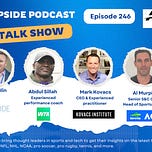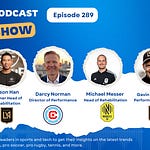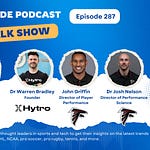This week we had the honor to interview a group of ATP/WTA sports performance experts in pro tennis.
Al Murphy, senior S&C coach at Tennis Australia. Al works with tennis players such as Rinky Hijikata, Emerson Jones and Aleks Vukic. He is also the head of sports science at Tennis Australia.
Abdul Sillah, an experienced performance coach. Abdul has worked with top players such as Serena Williams, and Naomi Osaka.
Mark Kovacs, CEO of Kovacs Institute, and Executive Director, International Tennis Performance Association.
📝Show Notes: Through this interview, we touched on the following topics:
With the ATP and WTA calendars more packed than ever, how top players and their teams adapting training and recovery protocols to handle the relentless travel and match load.
In such a physically demanding and competitive era, what specific innovations in strength, conditioning, and on-court movement training are giving players an edge.
How teams are balancing the need for recovery—sleep, nutrition, soft tissue work—with the pressures of back-to-back matches, media obligations, and constant travel.
Given how tight the margins are in the top 100, how practitioners are helping players gain psychological and physiological resilience—especially after tough losses or during long tours.
As the game continues to evolve—with more power, speed, and longer rallies—how training methods are adapting to meet the demands of modern tennis.
You can read the full transcript of the podcast interview with Abdul, Al and Mark located at the top of this blog post.
Here are some of the best quotes of our conversation with them:
1. Adapting Training and Recovery to a Packed Calendar
Al Murphy (Tennis Australia):
“For players who aren't cemented at the very top — not the seeded players at Slams — they’re often playing week in, week out to chase ranking points. For them, we’re always balancing short bursts of training with recovery between matches, especially when they only win one or two rounds. They don’t have the luxury of time. For the top players, it's a different story — they can afford to skip some 250s or even 500s to manage their load and preserve performance. But across the board, what’s really tough is the mental toll: the monotony of weekly losses, the pressure to perform, and the constant travel. That’s what adds up. That’s where you see burnout."
Mark Kovacs (Kovacs Institute):
“Unlike team sports, tennis players don’t know their schedule more than a few weeks out. It’s chaos compared to the NFL or NBA, where you get your calendar a year in advance. Here, a player might enter three tournaments hoping to qualify for just one — that unpredictability changes everything. As a coach or performance specialist, you have to be flexible and ready with different workouts based on whether your athlete wins, loses, travels last-minute, or picks up an extra match. It’s a constant adaptation game. And if you're someone who likes predictability, this environment probably isn’t for you.”
Abdul Sillah (Performance Coach):
“For me, it’s all about preparation — but not just physical. It’s about getting the mind ready for uncomfortable situations. That’s where most players fall apart — not because of physical fatigue, but because they’re mentally unprepared for the grind. When I worked with Naomi (Osaka), I knew I had to build her resilience before we built her strength. It’s exciting because you’re forced to get creative — adapting schedules, being a psychologist, sometimes just being there to calm them down and help them make sense of what’s happening.”
2. Innovations in Strength, Conditioning, and On-Court Movement Training
Abdul Sillah:
“I’ve always been a bit old school — foundational movement comes first. But one tool that’s really changed how I work is the Quick Board. It allows me to be hands-off, so I can observe. It measures cognitive response and movement quality in real time. It helps train the brain-body connection — essential in a sport like tennis where decision-making, anticipation, and precision all happen in milliseconds. That’s my go-to for building efficient movement under pressure.”
Al Murphy:
“We use Blaze Pods during travel — simple but effective for reaction and cognitive drills. On the court and in the gym, we've leaned into contraction-specific technologies like flywheels and the 1080 Quantum, which we use both for traditional resistance and for tennis-specific overload. But a real game-changer has been wearable resistance like Lila — it’s light, versatile, and allows players to train with resistance during actual tennis movement. You can place the weight to assist or resist movement patterns. It becomes a feedback tool — helping athletes feel changes and self-correct, without sacrificing speed or technique.”
Mark Kovacs:
“I still swear by heart rate. We’ve got decades of trusted data — it’s still incredibly valuable for conditioning and workload monitoring. Velocity-based training is another one — it teaches players that strength without speed is useless in tennis. The goal isn’t to deadlift more; it’s to move explosively off the mark. But here’s the issue: a lot of products out there have error rates of 20 to 30 percent. Athletes are making performance decisions off unreliable data. Sometimes I tell people — you’re better off using nothing than using something that gives you false confidence.”
3. Balancing Recovery with Travel and Obligations
Abdul Sillah:
“For me, this part — sleep, recovery, nutrition — this is the easiest to control because it’s non-negotiable. I tell every athlete: the best athlete is the one who’s available. If you’re injured or constantly rundown, you’re no use to your team or your sponsors. A lot of tennis players don't prioritize nutrition until it’s too late. They think they can out-train a poor routine. We set strict discipline early: how you eat, when you rest, how you recover — these are all foundational. Without it, you’re building on sand.”
Al Murphy:
“It really is a team game behind the scenes. The player might be the CEO, but they need to trust the advice of coaches, physios, nutritionists. At the top level, these routines are well-established. You’ll see ice baths, compression, soft tissue, meal prep — but it’s tailored to the player, the surface, match finish time, and next match day. We also focus a lot on tendon health and load management — not just what’s sexy, but what keeps athletes durable for the long haul.”
Mark Kovacs:
“Recovery is where the industry’s exploding — there are 10 new gadgets every month. The problem? Athletes start trying everything. It becomes a recovery circus — infrared this, cryo that. The best athletes keep it simple. They don’t chase fads. They find what works — low risk, high trust — and they do it religiously.
In tennis especially, the issue is there’s no regulation on who can call themselves a coach or trainer. So you’ve got people giving recovery advice without the experience or science to back it up. That’s a huge risk.”
4. Helping Players Build Resilience During Long Tours or After Losses
Mark Kovacs:
“One of the most powerful traits in elite players is their short-term memory. They can lose a match and bounce back like it never happened. That’s not just genetics — that’s training. They’ve got a structure, a support team that knows what to say and when to say it. When a player starts spiraling after losses, that team can redirect their focus — emotionally, tactically, physically. The problem is, many players change coaches because that connection isn’t there. But when it is, that bond becomes a competitive advantage.”
Al Murphy:
“Our Aussie players often leave home in February and don’t return until November. That kind of travel can really wear you down. We try to create small ‘home bases’ — former colleges, family stops in Europe, apartments in the UK. Little anchors of normalcy. These stops let players reset — mentally and emotionally — so that the next tournament doesn’t feel like another brick in the wall. That’s where resilience really starts — off the court.”
Abdul Sillah:
“It’s about knowing the player — their psychological makeup, their triggers. You start by watching how they react in training. When they lose, we help them zoom out. One match doesn’t define them. We build protocols for tough stretches — that might mean bringing in family, taking a break from the team, or just getting off the grid for a few days. And from the start, we teach them that failure is part of the process. If you learn from it, it’s not a loss.”
5. Adapting Training to the Power and Speed of Modern Tennis
Abdul Sillah:
“When I started working with Naomi, people laughed when I said my goal was to create the perfect athlete — not just a tennis player, but a hybrid. I wanted the mindset of a boxer, the conditioning of a soccer player, the agility of a basketball player, the explosiveness of an NFL athlete. People said it couldn’t be done. But when she came on the scene and dominated, suddenly they understood. That’s the future of tennis — real athletes, not just skilled players. You have to go where others aren’t willing to go.”
Mark Kovacs:
“The game is evolving at breakneck speed — players are taller, faster, hitting harder. Court surfaces are grittier, rallies are longer. But here’s the problem: the faster the game, the more strain on the body. And unlike other sports, tennis has no real off-season. If you go weeks without proper training, you drop off. So you need to condition during competition, which is a nightmare puzzle for practitioners. The ones who succeed are the ones who can endure — who do the boring stuff right, every single day.”
Al Murphy:
“Taller players used to just rely on their serve. Now they’re moving like the smaller guys. So we’re solving a new set of problems: how do we prepare a 6’6” guy to slide, pivot, and change direction without blowing out his knees? The answer starts early. We need to train movement efficiency and joint resilience in the development phase — when they’re 14, not 24. By the time they hit the tour, we don’t have time to teach fundamentals anymore. That’s why we use tech like motion tracking, wearables — to build a predictive, long-term roadmap for each athlete’s body and playing style.”
You may also like:
🔥Upside ATP/WTA Group Chat with Al Murphy (Tennis Australia), Abdul Sillah & Zack Evenden on Training, Rehab, Sleep management, Mental Toughness & Innovation in Pro Tennis.
This week we had the honor to interview a group of ATP/WTA sports performance experts in pro tennis.
🎾Upside Chat with Abdul Sillah, A World’s Class High Performance Coach For Top Athletes (Serena Williams, Naomi Osaka, Aaron Aaron Hicks / New York Yankees)
Today we have the honor to interview Abdul Sillah, a world's class high performance coach who has worked with top athletes such as top tennis players, like Serena Williams, Naomi Osaka, Sloane Stephens, Bianca Andreescu. He also worked with MLB/NFL players.
🔥 Upside Chat: Machar Reid, Innovation Lead (Tennis Australia)
This week we have the honor to interview Machar Reid, the head of Innovation of Tennis Australia who owns the Australian Open Tennis, and the new tech fund Wildcard Ventures.














